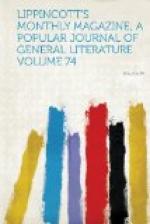Following the fate of so many other places, Brome passed after the death of the second marquis to a novus homo, one Matthias Kerrison, who, having begun life as a carpenter, contrived in various ways to acquire a colossal fortune. His son rose to distinction in the army, obtained a seat in Parliament, which he held for thirty years, and was created a baronet.
He left at his death a son and three daughters. The former, long married, is childless. The sisters are respectively the wives of Earl Stanhope, the well-known historian; Lord Henniker, a wealthy Suffolk proprietor; and Lord Bateman. It is understood that under the late baronet’s will the son of the last will, in the event of the present baronet dying childless, succeed to the property. It will thus be observed that Brome, after having been for four centuries in one family, is destined to change hands repeatedly in a few years.
When the second Marquis Cornwallis died sonless, the marquisate became extinct, but the earldom passed to his first cousin. This nobleman, by no means an able or admirable person, married twice. By his first marriage he had a daughter, who married Charles Wykeham-Martin, Esq., M.P., whose father, by a concatenation of chances, became the owner of Leeds Castle, near Maidstone, in Kent—a splendid moated baronial pile, dating from the thirteenth century, but added to and improved in admirable taste. Leeds was formerly the property of the Fairfax family, whose chief, the present lord, resides near Washington. It came to them from the once famous family of Colepepper.
Earl Cornwallis married a second time late in life, and had an only daughter, Lady Julia. From that time his one idea seemed to be to accumulate for this child, and accordingly at his death she was the greatest heiress in England, her long minority serving to add immensely to her father’s hoards. Of course, when the time approached for her entering society under the chaperonage of her cousins, the marquis’s daughters, speculation was very rife in the London world as to whom she would marry, and many a mamma of high degree cast sheep’s eyes at the heiress, and thought how charmingly her accumulations would serve to clear the encumbrances on certain acres. But they were not kept long in suspense. One night during the London season, when the ladies Cornwallis gave a grand ball, a damper was cast over the proceedings, so far at least as aspirants to the heiress’s money-bags were concerned, by the announcement of her engagement. Said a lady to a gentleman in the course of that evening, “Most extraordinary! There seem to be no men in the room to-night.” “Why, of course not,” was the rejoinder, “after this fatal news.” Lady Julia’s choice fell upon a young officer in the Guards, Viscount Holmesdale, eldest son of Earl Amherst. Lord Holmesdale was unexceptionable in point of position, but his pecuniary position was such as to make one hundred and fifty thousand dollars a year a very agreeable addition to his income. It may, however, be a satisfaction to those less richly endowed with this world’s goods than Lady Holmesdale to reflect that being an heiress generally proves rather the reverse of a passport to matrimonial bliss; and by all accounts she is no exception to the usual fate in this respect. We can’t have everything in this world.




